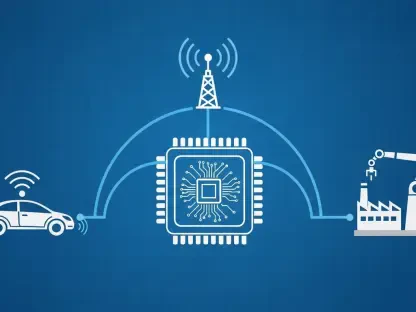The Cloud Radio Access Network (C-RAN) market is witnessing an unprecedented boom, fundamentally reshaping the telecommunications sector with its groundbreaking approach to network design and functionality. By centralizing and virtualizing key network operations, C-RAN delivers exceptional scalability, operational efficiency, and significant cost reductions, positioning it as a vital component of modern connectivity solutions. This article explores the primary catalysts behind its rapid expansion, ranging from the worldwide implementation of 5G technology to the adoption of innovative tools like artificial intelligence and cloud-based systems. C-RAN stands as a transformative force for telecom providers, enterprise sectors, and smart urban initiatives, adeptly addressing the escalating needs driven by mobile data consumption and the widespread growth of Internet of Things (IoT) applications. The market’s projected climb from USD 9,169 million in 2024 to an impressive USD 106,430 million by 2035, with a compound annual growth rate (CAGR) of 24.6%, underscores a seismic shift in global communication paradigms. This surge reflects not just technological progress but a deeper evolution in how digital connectivity integrates into everyday life, powering everything from high-definition streaming to industrial automation.
The Backbone of 5G and Surging Data Needs
The explosive growth of the C-RAN market is intricately tied to the global rollout of 5G networks, which require robust, adaptable infrastructure to manage massive data volumes with speed and reliability. Telecom operators across the globe are increasingly relying on C-RAN to facilitate this transition, as it offers a cost-effective way to scale operations while maintaining high performance for millions of connected users. The architecture’s ability to centralize baseband processing reduces the need for extensive physical hardware at cell sites, thereby cutting expenses and simplifying network management. As 5G continues to expand into urban and rural areas alike, C-RAN emerges as an indispensable solution, enabling providers to meet stringent latency and bandwidth demands that define the next generation of wireless technology. This alignment with 5G’s requirements positions C-RAN as a critical enabler in the race to deliver seamless, high-speed connectivity on a global scale.
Another driving force behind C-RAN’s ascent is the relentless increase in mobile data traffic, fueled by consumer behaviors and technological trends that show no signs of slowing. Activities such as streaming ultra-high-definition videos, engaging in immersive online gaming, and utilizing IoT devices for smart homes and cities are pushing networks to their limits. C-RAN addresses these challenges by providing a high-capacity framework that can dynamically allocate resources based on real-time demand, ensuring consistent performance even during peak usage periods. Unlike traditional network setups, which struggle to adapt to sudden spikes in data consumption, C-RAN’s flexible design supports the diverse needs of modern applications. This capability is particularly crucial as IoT ecosystems expand, connecting billions of devices that require constant, reliable communication. By tackling these escalating data demands head-on, C-RAN not only supports current usage patterns but also lays the groundwork for future digital innovations.
Innovations Shaping the C-RAN Landscape
Technological advancements play a pivotal role in propelling C-RAN adoption, with artificial intelligence (AI) and cloud-native architectures emerging as game-changers in network optimization. AI integration allows for real-time monitoring of network health, enabling predictive maintenance that minimizes downtime and enhances user experience through automated adjustments. Meanwhile, cloud-native designs reduce reliance on traditional hardware by centralizing functions in virtual environments, leading to substantial savings in both cost and energy. These innovations make C-RAN an attractive option for operators looking to streamline operations while maintaining cutting-edge performance standards. As AI continues to evolve, its synergy with C-RAN promises even greater efficiencies, potentially revolutionizing how networks are managed and scaled in response to ever-changing demands.
Equally significant is the industry’s pivot toward virtualized and open Radio Access Network (RAN) models, which are redefining the competitive and operational dynamics of telecommunications. Virtualized RAN (vRAN) and Open RAN (O-RAN) break away from proprietary systems, fostering an ecosystem where multiple vendors can contribute components, thus driving down costs and spurring innovation. This shift not only democratizes access to advanced network solutions but also accelerates the deployment of C-RAN by reducing dependency on single suppliers. The flexibility of these models allows for rapid adaptation to new technologies and market needs, ensuring that C-RAN remains at the forefront of telecom evolution. Furthermore, the emphasis on interoperability aligns with global efforts to create more inclusive and sustainable network infrastructures, amplifying C-RAN’s appeal across diverse regions and industries seeking modern connectivity solutions.
Enterprise Adoption and Global Variations
C-RAN’s influence extends far beyond traditional telecom boundaries, as enterprises across various sectors recognize its potential to revolutionize their connectivity frameworks. Industries such as manufacturing, logistics, and urban development are increasingly deploying private 5G networks powered by C-RAN to support mission-critical applications like automated production lines, real-time inventory tracking, and smart city traffic management systems. This architecture provides the reliability and low latency necessary for such high-stakes operations, enabling businesses to optimize processes and enhance productivity. As more companies invest in digital transformation, the demand for tailored C-RAN solutions grows, positioning it as a cornerstone of enterprise connectivity strategies that prioritize efficiency and innovation in an increasingly connected world.
Regional dynamics also play a crucial role in shaping C-RAN’s growth trajectory, with distinct patterns of adoption emerging across the globe based on economic and policy factors. North America currently holds a leading position, driven by substantial investments in 5G infrastructure and early adoption by major telecom operators. In contrast, Asia-Pacific is experiencing the fastest growth, propelled by large-scale projects in countries like China and India, where rapid urbanization and dense populations amplify connectivity needs. Europe, on the other hand, focuses on sustainability and open standards, with policies encouraging diversified vendor ecosystems to support C-RAN deployment. These regional variations highlight how local priorities—whether technological advancement, population demands, or environmental goals—shape the pace and nature of C-RAN integration, illustrating its versatility as a solution adaptable to diverse global contexts.
Competitive Forces and Long-Term Horizons
The C-RAN market is marked by fierce competition among industry giants and specialized innovators, each vying to define the future of network technology. Global leaders such as Nokia, Ericsson, and Huawei are investing heavily in research and development to push the boundaries of C-RAN capabilities, often through strategic collaborations that enhance their offerings. Recent initiatives, like Nokia’s focus on AI-driven RAN solutions and Ericsson’s launch of advanced 5G software for spectrum efficiency, demonstrate a commitment to addressing both current needs and future challenges. These competitive efforts not only drive technological progress but also ensure that C-RAN remains a dynamic field, constantly evolving to meet the demands of an increasingly digital landscape. The rivalry fosters a cycle of innovation that benefits end-users through improved services and cost efficiencies.
Looking ahead, the long-term potential of C-RAN appears boundless, as it transitions from a telecom-centric technology to a foundational element of broader digital ecosystems. Its role in enabling the evolution from 5G to prospective 6G networks signals a future where connectivity underpins every facet of industry and society. Beyond telecommunications, C-RAN is poised to redefine enterprise operations and smart city frameworks by providing the infrastructure needed for complex, data-intensive applications. However, challenges such as high initial deployment costs and data security concerns must be addressed to fully unlock this potential. As stakeholders continue to refine solutions and strategies, C-RAN stands ready to support the hyper-connected economy of tomorrow, offering a scalable, sustainable path forward for global communication needs that will shape technological landscapes for decades to come.









